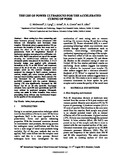| dc.description.abstract | Meat curing is a time consuming and labor intensive process. Power ultrasound (US) induces cell disruption and
increases mass transfer. This study aims to assess whether US can accelerate the transfer of brine into meat and
to assess the effect of US on the meat quality parameters. Pork M. longissimus thoracis etlumborums amples were placed in adiffusion cell. Brine (6% NaCl) was placed on top of the sample allowing for unidirectional diffusion and an ultrasonic probe was placed in the brine. A 3 x 3 factorial design was applied with ultrasonic
intensities of 44, 72 or 100 W/cm2 and treatment times of 10, 25 or 40 min. A non-sonicated cured sample acted as the control. Samples were analyzed for changes in NaCl content, moisture content, weight, pH, color, texture profiles, cook loss and water holding capacity. NaCl content (%) was increased by all ultrasonic treatments
(p<0.001) compared with the control. Moisture content (%) was significantly increased by 100
W/cm2 for 10 or 25min (p<0.05). Decreased cohesion force (p<0.05) and gumminess (p<0.05) were evident in sonicated samples. Ultrasonic curing can assist in brine transfer, thus reduce processing times without any detrimental impact on the quality of the end-product | en_US |

